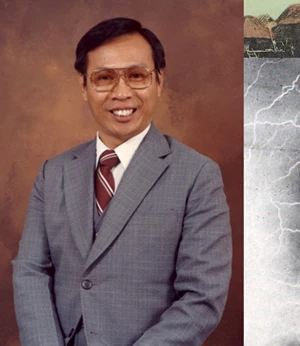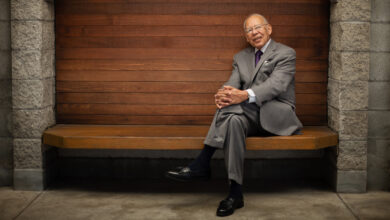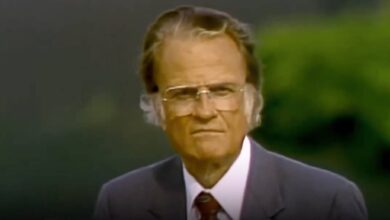How a Radio Current Jolted a Christian Leader int…

When the late Federico “Fred” Mission Magbanua Jr. preached a radio sermon on offering one’s body as a living sacrifice, he probably didn’t imagine he’d one day hear these words again as a 10,000-watt radio frequency current surged through him in a near-death accident.
It happened one night in early 1961, while Magbanua was working at the Far East Broadcasting Company (FEBC) gospel radio ministry. He was mulling over a job offer in the United States with a salary far greater than what he currently made as an FEBC engineer and as a pastor of a small Baptist church.
Suddenly, the warning lights on the 308-foot radio tower went out. Magbanua loaded some new bulbs into a bag and began climbing the structure. From his home nearby, his daughters and his wife, Aliw, watched him scale the tower.
What Magbanua didn’t realize was that the grounding system—which diverts energy to the ground to prevent surges—wasn’t working. A radio frequency current “hit his head using his body as a lightning rod,” his friend Harold Sala later told God Reports. “Literally, he was being executed by the tremendous surge of electrical power.”
The program that was airing at that moment was one that Magbanua himself had hosted on Romans 12:1–2. “Through the sparking, he heard his own voice in his head saying, ‘Therefore, I urge you, brothers, in view of God’s mercy, to offer your bodies as a living sacrifice,’” recounted former FEBC head Dan Andrew Cura.
Miraculously, Magbanua was released by the current and fell to a step that was several feet from the top of the tower instead of falling 300 feet to the ground. He managed to climb down the ladder and get to the company nurse’s office, where he collapsed. When Aliw later saw him in the clinic, he was swaddled in towels like a baby, his whole head of hair burnt. He ended up hospitalized for months, as doctors had to graft skin from his thighs to cover the lost skin on his head.
Yet the experience “literally jolted him out of his reasoning” to leave the country, Cura said. Once he was healed, Magbanua lived and served in the Philippines until his death in 2013. He worked for FEBC for the next 33 years, including as its first non-American managing director. After that, he went on to start a church-planting movement that sought to establish “a church in every barangay” (or neighborhood). He also influenced a new generation of Filipino evangelical leaders, including Efraim Tendero, the former secretary general of the World Evangelical Alliance.
In a day and age where church scandals go viral far too often in the Philippines, many church leaders say they found in Magbanua a model for living a life of integrity and finishing the race well.
“He showed me how to have a heart that genuinely serves God,” Tendero told Evangelical Today TV. “He exemplified how to conduct one’s self and, when dealing with controversy, not to be swayed.” Tendero added that Magbanua maintained this principle in ministry to stay “right before God.”
Humble beginnings
Magbanua was born in 1932 in the central Philippine province of Negros Occidental, the son of a fisherman. His family was poor, and as a young boy, Magbanua walked five kilometers (about three miles) barefoot to attend school. He was in high school when he heard the gospel and committed his life to Christ while listening to an FEBC program under a mango tree. He ended up studying civil engineering at the Mapúa Institute of Technology (now Mapúa University) in Manila while working odd jobs.
In 1957, Magbanua met and married Viola Aliw Cachola, then an English teacher. He bought a wedding ring for 20 pesos (36 cents) and the wedding ceremony took place at a missionary’s garden on Thanksgiving Day.
Magbanua’s first ministry assignment was to start a local church in the town of Victoria in the province of Laguna. He and his wife would receive 35 pesos (62 cents) a month as ministry support, which meant that sometimes they would eat only one meal a day.
“You married a pastor and now you’re going to die of hunger,” Aliw remembers her mother telling her. She retorted, “Don’t worry, I’m happy here even if we’re not eating.”
As their family grew—the Magbanuas would have five children—the pastor was tempted to find more profitable work in the United States. When he told Aliw that the move would allow him to give the money he made to God, she was firm: “I do not agree with your plan,” she remembers saying. “We have to stay here.”
Then, after the shocking tower experience, Magbanua himself felt convicted to stay.
FEBC and beyond
In 1965, Magbanua became chair of the newly founded Philippine Council of Evangelical Churches (PCEC), which then had only 11 member churches. A breakaway entity from the progressive National Council of Churches in the Philippines, PCEC wanted to emphasize evangelism over social justice. Today the umbrella group has 55,000 member churches.
For the next three decades, Magbanua worked at the gospel radio station. At first, he was the head of engineering, and he eventually worked his way up to managing director of the ministry. In 1971, Magbanua became the first Filipino to head FEBC Philippines, causing some jealous murmurs. His colleagues were used to “imported leaders” from America, his daughter, Joy Magbuana-Huerte, said.
While at the helm of FEBC, the ministry expanded into several local radio stations, including one that reached indigenous tribes on Mindoro Island. It also launched a Filipino gospel music label that produced 20 albums and earned awards from the Philippine press.
In a move that some find controversial today, the radio ministry remained silent when President Ferdinand Marcos declared martial law in 1972, ushering in his dictatorship. While other media groups who critiqued the move were shut down, FEBC was allowed to continue broadcasting.
Planting churches in the barangay
Magbanua stepped down from FEBC in 1992 as he reached the retirement age of 60. “But I’m still young,” he said in the early 2000s. “I think I may still be useful in advancing God’s kingdom.”
He looked to his country’s rural areas, where many of the estimated 42,000 barangays—the smallest administrative unit in the Philippines, overseen by the local city or municipal government—didn’t have an evangelical church.
Image: Illustration by Mallory Rentsch Tlapek / Source Images: WikiMedia Commons / Portrait Courtesy of FEBC
Official portrait of Fred Magbanua in the 1980s as managing director of FEBC.
“I made a promise to the Lord that I will look for barangays without a church and help pastors working there,” Magbanua said in the video. He explained that pastors serving in remote areas usually leave and give up because of hardship. “In those barangays, you’d be blessed if you had a monthly offering totaling 500 pesos,” he said, an amount around $10.
Magbanua-Huerte, who served as her father’s executive assistant after he retired, said her father wanted to plant holistic churches that not only preached the gospel but provided health care, education, and financial help. Because of Magbanua’s own experience growing up in poverty, he understood the difficulties that pastors and their families face when planting churches in impoverished areas.
“People [there] don’t have jobs,” he said. “They would tithe chicken, eggs, banana, pumpkin, and fish. Yes, the pastors would have something to eat, but when their children get sick, they have no money for medicine. When their kids need to go to school, [there’s] no money for fees.”
The idea to plant holistic churches in unreached barangays, however, didn’t pan well with his fellow Baptists, who were more focused on discipleship, according to Magbuana-Huerte. Instead of causing conflict, Magbanua decided to leave the denomination and, with their blessing, he started Christ Jesus Our Life in 1992, a church-planting movement.
His movement started a pastoral support fund inspired by 2 Corinthians 8:15, where 40 percent of a local church’s income went into a common fund that was then divided among all the pastors within the movement. This was to help church leaders serving in more economically depressed areas.
He urged Filipino church leaders to prioritize church planting and was also mindful of the church’s location, emphasizing that it must be at most a ten-minute walk from where members lived so they wouldn’t have to pay for public transportation to get to church.
“His desire is [that] every barangay, every Filipino who needs to know the Lord, will have access to a place where they can hear the gospel,” Aliw said. “Even if they are deeply impoverished, they can still afford to go to church.”
Today Christ Jesus Our Life has around 160 churches. Magbanua-Huerte pastors in the Philippine province of Palawan and oversees around 40 congregations, half of which are in indigenous communities. Reminiscent of where her father first heard the gospel, several congregations conduct their services under a mango tree.
Mediator and religious statesman
Several people close to Magbanua noted the consistency in his witness. For instance, he maintained the same rigor and discipline in preparing for his sermons well into his 70s. On a sheet of paper folded into thirds, he would jot down his outline filling each section with the beginning, middle, and end. His wife said he would usually prepare for his preaching at least a week in advance.
“My dad really preached from the Word,” said his eldest daughter, Grace Vowell. Regardless of the sermon’s topic, he would always end it with an invitation to commit one’s life to Jesus Christ.
As a founder of a growing denomination and an elder among evangelical leaders, Magbanua offered advice to other church leaders who came to him and mediated internal conflicts. Rey Corpuz, the former head of the Philippine Missionary Association, recalls a time when evangelicals and Pentecostals did not work with each other.
“There’s a funny side to Manong Fred,” Corpuz said, using the title for an elderly person or person of stature. “He baptized himself as a Bapticostal.” A conservative Baptist, Magbanua actively built relationships with Pentecostals, which drew criticism from his peers.
In July 2012, family and friends celebrated Magbanua’s 80th birthday with the theme “From a son of a fisherman to a fisher of men.” Vowell said that her father prayed to live another ten years, as he hoped to see Christ Jesus Our Life plant 300 churches by 2023. Yet she also recalled him saying, “If [God] wants to take me, that’s fine—I’m ready.”
Several months later, Magbanua went to get an endoscopy and doctors informed him that he had stage IV stomach cancer. He died three months later on January 21, 2013.
“He started strong, he started well in the ministry, and up until his last breath, he was anointing a new, younger leader,” said Noel Pantoja, who viewed Magbanua as a second father. Pantoja served with Magbanua planting churches with Christ Jesus Our Life and later established several Filipino-American congregations in Washington, DC.
“If you … rely on your own strength and your own wisdom, you cannot do it,” Pantoja remembers Magbanua telling him from his hospital bed. “If you feel you’re not capable of doing it, that you are not qualified, that’s the first qualification, because you will depend on the power of God, the power of the Holy Spirit.”




